Like other animals, goats can also be variegated. Based on the breed, the solid hues of goat coats vary. Black and white is the most common color combination for goats.
The black and white goat breeds include the Tennessee Fainting goat, Maltese goat, French Alpine, Vallesana, Peacock goat, Jining Grey, British Alpine, Frontalasca goat, and Bagot.
9 Black and White Goat Breeds
Tennessee Fainting Goat
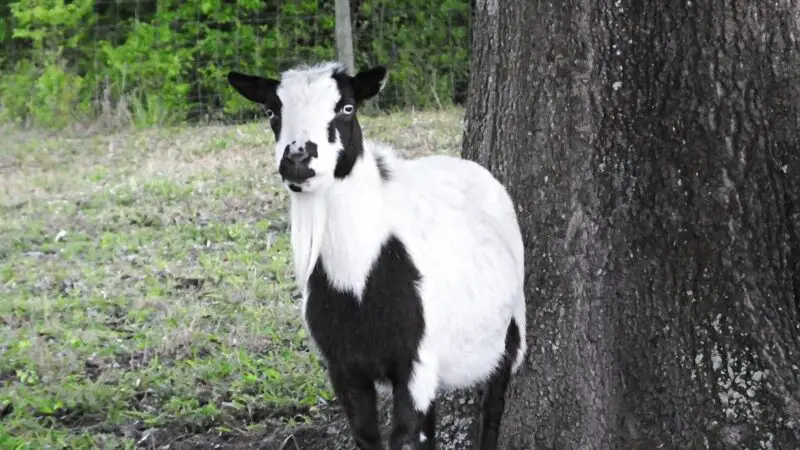
The Tennessee Fainting goat is often referred to as Texas Wooden Leg. Their name derives from Myotonia congenita, a condition in which the goat’s muscles spasm for an extended amount of time when they are terrified.
- Appearance: Short-legged with deep and wide-bodied
- Lifespan: 12-15 years
- Height: 17-25 inches
- Weight: Female goats range in weight from 60 to 174 lbs, whereas male goats, or bucks, can weigh up to 200 lbs.
- Place of Origin: In the 1880s, the first fainting goats were introduced to Marshall County, Tennessee. The gene mutation that causes this muscular stiffness in goats was found in 1996.
- Characteristics: This goat is unique because it has Myotonia congenita, a genetic disorder that can lead it to stiffen or trip when agitated or frightened.
- Purpose: Tennessee is deep-chested, heavy-rumped goats that are mainly bred for meat. Female goats are good for the production of milk and dairy products.
Maltese Goat
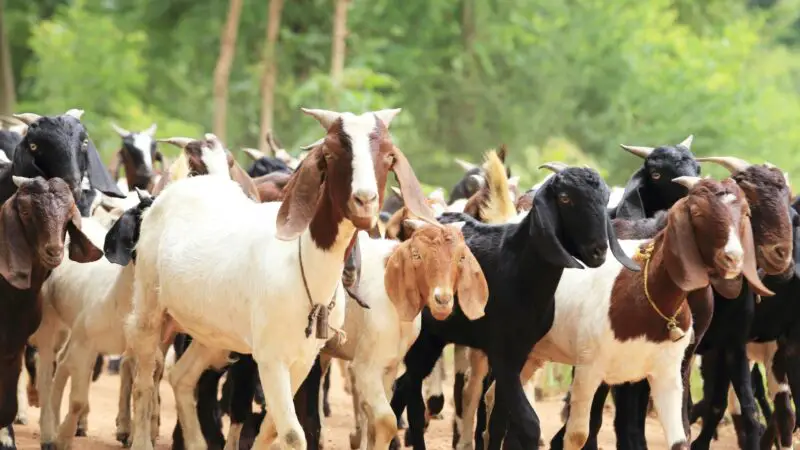
A domestic goat breed native to the Eastern and Central Mediterranean region. Associazione Nazionale Della Pastorizia, the national organization of Italian sheep- and goat-breeders, maintains a genealogical herdbook for the Maltese goats.
- Appearance: Average size with lengthy hair. They also have large ears, and the top and sides of their heads are covered with raven black. They feature black sides, a black head, and white sides with black ears.
- Lifespan: 10-15 years
- Height: 87 cm for males and 71 cm for females on average
- Weight: 154 pounds
- Place of Origin: The term “Maltese goat” comes from the island of Malta. However, the animals come from Asia Minor. They grow up on the Southern Italian islands of Sicily and Sardinia.
- Characteristics: One of the eight indigenous Italian goat breeds. About 70000 Maltese goats were believed to be present overall in 1983, and 40000 were estimated to exist in 2005.
- Purpose: Breed of dairy goat that is primarily used to produce milk. These goats’ milk is used to make the traditional caprino and ricotta cheeses in Sicily.
French Alpine
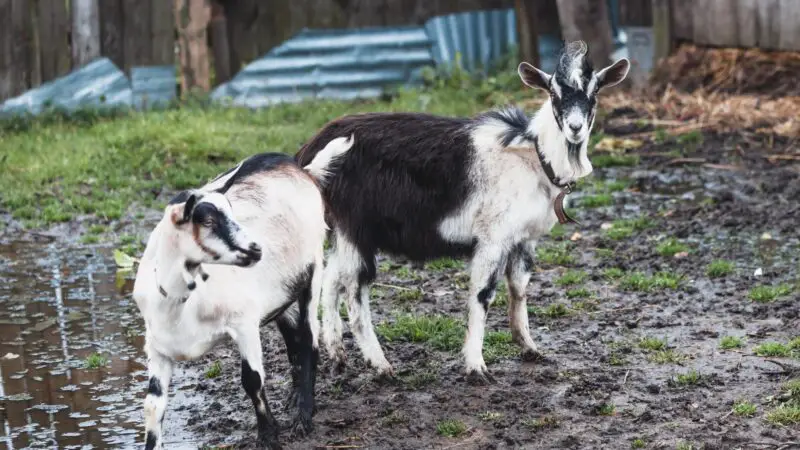
These are hardy, adaptable animals that thrive in any climate while maintaining good health and excellent production. French Alpine goats are domestic dairy goats, which are one of the most commonly kept breeds.
- Appearance: Medium to large-sized breed. They have horns, a straight profile, and erect ears.
- Lifespan: 15-18 years on average
- Height: Females are 30 inches, and males are 30 to 40 inches at the withers.
- Weight: Females weigh at least 135 pounds and males at least 170 pounds.
- Place of Origin: Originated from the French Alps, the sections of the Alps mountain range that are inside France. This is located in the Auvergne-Rhône-Alpes and Provence-Alpes-Côte d’Azur regions.
- Characteristics: Compared to Swiss breeds, the French-Alpine goat is bigger, rangier, and more varied in size.
- Purpose: They produce high-quality milk that is used to make butter, soap, and cheese.
Vallesana
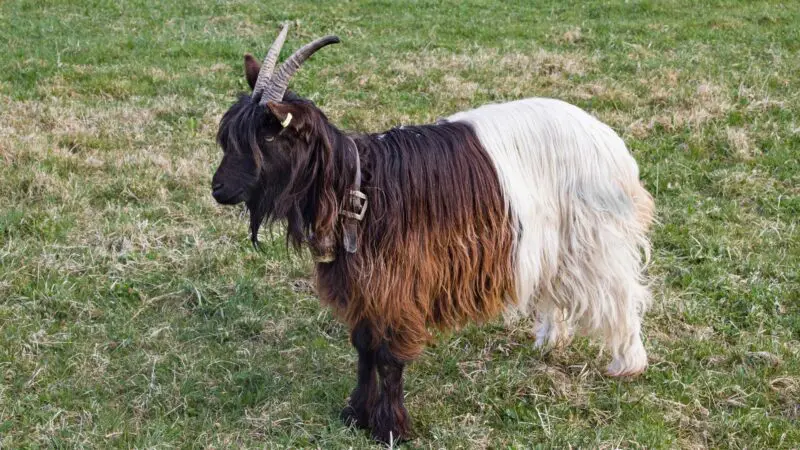
This mountain goat, sometimes known as the Glacier Goat, can withstand very harsh weather conditions. Additionally, its legs are solid and powerful, letting it graze at great elevations.
- Appearance: Have wavy, long hair and medium-length horns
- Lifespan: 6-10 years
- Height: Male is 29-33 inches at the withers, and females from 27-31 inches.
- Weight: Male weigh 165 lbs while females 121 lbs.
- Place of Origin: They are native to the region separating the Italian province of South Novarese from the Swiss canton of Valais.
- Characteristics: This goat has also considered a semi-hairy goat, and the line between both colors is impressive and well-defined.
- Purpose: Vallesana produces milk but is mostly raised for its meat.
Peacock Goats
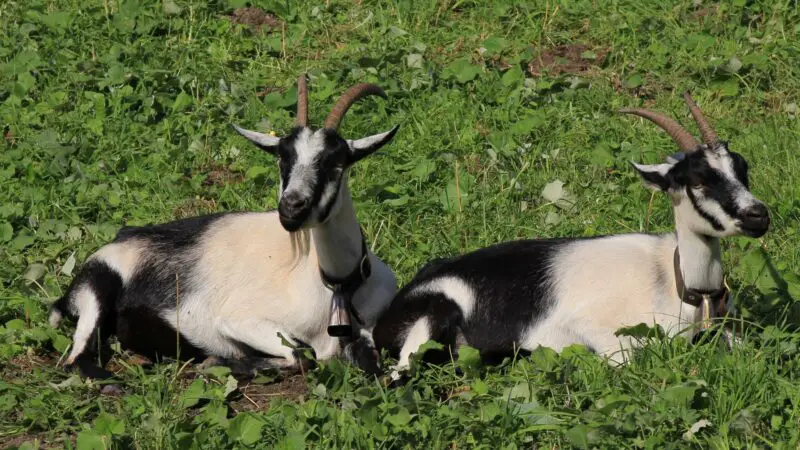
Peacock goats are dispersed over the whole of Switzerland and are used to produce milk.
- Appearance: Peacock goats have enormous horns with black stripes or spots at the base, above the eyes, and on the nose.
- Lifespan: 8-9 years
- Height: 15-19 inches
- Weight: 18-20 kilograms
- Place of Origin: Native to the Swiss cantons of Upper Tessin and Graubünden
- Characteristics: After its discovery, it was first referred to as the Striped goat. Due to a reporter’s misspelling, it was corrected to the Peacock goat.
- Purpose: They are primarily bred for milk production.
Jining Grey
Jining Grey is a domestic goat breed used for the production of kid fur and cashmere fiber. The breed is renowned for the lovely, undulating patterns in its fur.
- Appearance: They are little goats with small bodies and horns.
- Lifespan: 12-18 years
- Height: 12-15 inches
- Weight: Buck is 33.2 kilograms, and females are 24.5 kilograms.
- Place of Origin: Jining Grey originated in Shandong Province of China.
- Characteristics: If well-raised, this goat often achieves maturity within 3-4 months and may have two or three offspring each year.
- Purpose: Its appealing wavy patterns make it ideal for cashmere fiber and kid fur production.
British Alpine
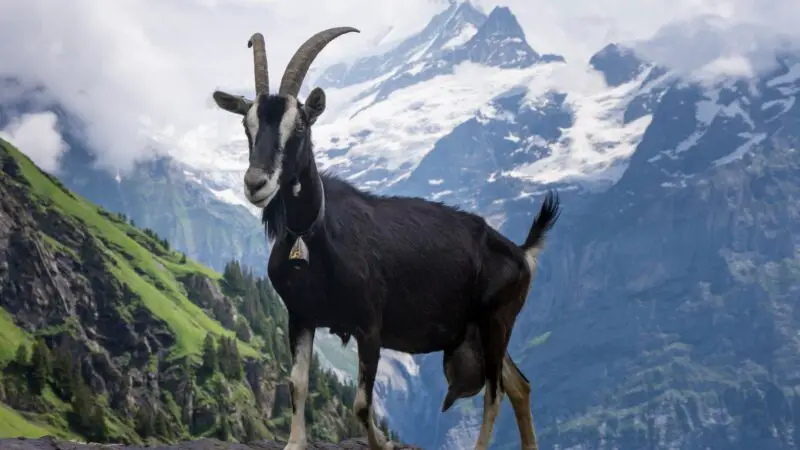
The domestic goat known as the British Alpine is bred primarily for its ability to produce milk. It has the same markings as the Swiss breed and was crossed with various other breeds.
- Appearance: The ears of a British Alpine are upright and point forward. Their coats are short, lustrous, and fluffy, except for the bucks, whose hair is normally longer.
- Lifespan: 8 to 12 years
- Height: Male is 27 inches, and females are 32 inches in withers.
- Weight: 70-77 kilograms
- Place of Origin: The British Alpine goat originated in Great Britain in 1903 by breeding foreign Alpine goats from Switzerland with native goats.
- Characteristics: British Alpines thrive best in temperate conditions and perform badly in humid regions.
- Purpose: The average fat output of British Alpine used for milk production is four percent because they have an extended lactation period, which contributes to their great milk production.
Frontalasca Goats
Similar to Swiss Grigionese goats. These animals are raised in the valleys of Valtellina, Val Malenco, Val Masino, and Valchiavenna. They are also domesticated goats that may be utilized for agricultural purposes.
- Appearance: Frontalascas have long, saber-shaped horns and dense, lustrous hair.
- Lifespan: 10-15 years
- Height: 78 to 81 inches
- Weight: 143-154 pounds
- Place of Origin: Originated from Frontalasca, Italy
- Characteristics: They are also known as Frisa goats because of the white streaks on their subcaudal regions, chests, and skulls.
- Purpose: Commonly used for meat production
Bagot
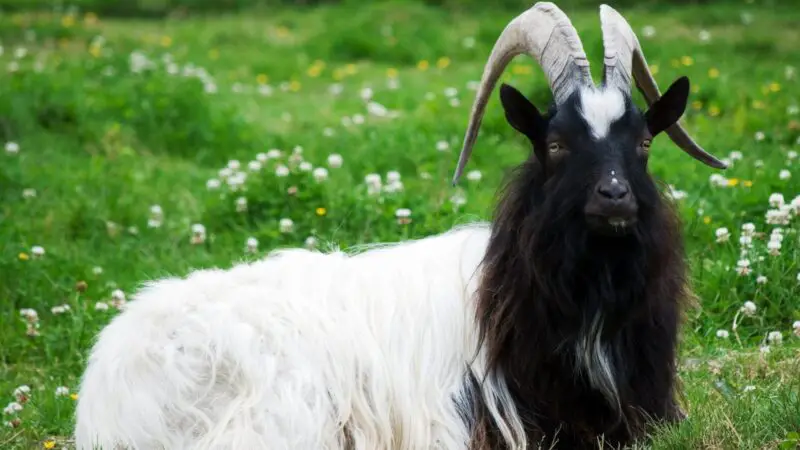
At Blithfield Hall in Staffordshire, England, Bagot goats have been living a wild lifestyle and are said to be the oldest breed of goat in Britain.
- Appearance: Their horns are enormous, curved, and sweep backward with a little twist.
- Lifespan: 10-12 years
- Height: 14-18 inches
- Weight: 100-150 pounds
- Place of Origin: Blithfield Hall in England
- Characteristics: Bagots are great, caring moms who can effectively feed their children because they are protective.
- Purpose: Conservation browsing uses Bagot goats and is often slaughtered.
Are Black and White Goats Rare?
Black and white goats are not rare. Just like brown, they are common on farms and grasslands. There are several breeds with distinctive patterns.
The most prevalent colors for goats are white, black, and combinations of the two. There are a few breeds that have a fair amount of coat color variation but are far more uncommon than breeds that have consistent coloring.
Related: 5 Best Small Goat Breeds | Unexpected Reasons to Have Them!
How Can I Tell What Breed My Goat Is?
The easiest way to tell what breed your goat is by their colors.
- If they are mahogany brown, they are Nubian goats.
- If they are solid black, they are Black Bengal goats.
- If a combination of white and black, they can be Tennessee Fainting or Maltese goat.
Also, you can identify the breed by their sizes.
- If they weigh at least 190-230 pounds, they are Boer goats
- If they weigh 150-170 pounds, they can be Alpine goats.
But if you want to be precise in knowing the breed of your goat, you can consult animal experts like veterinarians or farmers to identify the breed of your goat. They are the people who know about farm animals.
Related: How to Trim Goat Hooves | Easy-to-Follow Steps!
How Many Different Breeds of Goats Are There?
There are around 200 to 300 breeds of domestic and farm goats around the world, and breed-specific differences in size are significant. Nubian goats are the most common breed. The Nubian goat, also known as the Anglo-Nubian, has a variety of coat colors, although the most common is a mahogany brown with deep red overtones.
How to Identify Goat Breeds?
You can identify the breed of a goat by its shape, size, color and behavior. Also, goat breeds can be identified by their coats. Hairless goats are usually white or light brown and have no hair at all on their bodies.
Hairy goats have hair on their bodies, usually brown or dark brown. They can also be identified by their horns, which are mostly used for food production; hornless goats are used for wool production.
Goats are the most common animals on farms and in grasslands. We may also recognize their contribution to humans, especially in terms of their milk and meat production.
